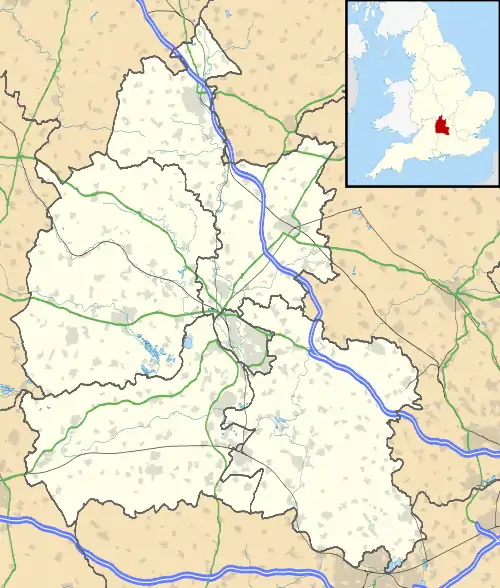Great Rollright
Great Rollright is a village and former civil parish, now in the parish of Rollright, in the West Oxfordshire district, in Oxfordshire, England, and about 2.5 miles (4 km) north of Chipping Norton.
| Great Rollright | |
|---|---|
_-_geograph.org.uk_-_407564.jpg.webp) St Andrew's parish church | |
 Great Rollright Location within Oxfordshire | |
| OS grid reference | SP3231 |
| Civil parish | |
| District | |
| Shire county | |
| Region | |
| Country | England |
| Sovereign state | United Kingdom |
| Post town | Chipping Norton |
| Postcode district | OX7 |
| Dialling code | 01608 |
| Police | Thames Valley |
| Fire | Oxfordshire |
| Ambulance | South Central |
| UK Parliament | |
| Website | "Rollright Review" |
The village has a Church of England primary school.[1]
History
The former Banbury and Cheltenham Direct Railway, part of the Great Western Railway, was completed in 1881. The line had a small railway station, Rollright Halt, 1⁄2 mile (800 m) south of Great Rollright. British Railways closed the halt in 1951 and the railway in 1964.
The village's former pub, The Unicorn Inn,[2] was controlled by Hunt Edmunds Brewery of Banbury until the company was taken over in the 1960s; it ceased trading in the late 1980s.
On the 23 December 1944, a United States Army Air Force, Boeing B-17 Flying Fortress (43-38812) was on a flight from RAF Portreath to RAF Glatton. The aircraft crashed while descending in darkness and fog 2 miles North of Great Rollright, killing 8 of the 9 crew.[3][4]
In 1931 the parish had a population of 289.[5] On 1 April 1932 the parish was abolished and merged with Little Rollright to form "Rollright".[6]
Landmarks
The megalithic Rollright Stones are about 1.5 miles (2.4 km) west of Great Rollright, near the Warwickshire village of Long Compton.
The Church of England parish church of Saint Andrew has Norman,[7][8] Early English,[8] Decorated Gothic[7] and Perpendicular Gothic[8] features. St Andrew's was restored in 1852 under the direction of the Oxford Diocesan Architect, GE Street.[8] St Andrew's is a Grade I listed building.[9] The west tower has a ring of six bells. William Bagley of Chacombe, Northamptonshire cast the fourth, fifth and tenor bells in 1695 and the third bell in 1696. W&J Taylor cast the second bell in 1839, presumably at the foundry they then had at Oxford. Henry I Bond and Sons of Burford cast the treble bell in 1899.[10] St Andrew's parish is now part of the Benefice of Hook Norton with Great Rollright, Swerford and Wigginton.[11]
References
- Great Rollright Church of England Primary School. Retrieved 11 May 3023
- Historic England. "The Unicorn Public House (Grade II) (1251361)". National Heritage List for England. Retrieved 3 September 2015.
- "43-38812 | American Air Museum in Britain".
- "Military crashes in the south west Midlands - 1944".
- "Population statistics Great Rollright CP/AP through time". A Vision of Britain through Time. Retrieved 19 August 2023.
- "Relationships and changes Great Rollright CP/AP through time". A Vision of Britain through Time. Retrieved 19 August 2023.
- Sherwood & Pevsner 1974, p. 623.
- Sherwood & Pevsner 1974, p. 624.
- Historic England. "Church of St Andrew (Grade I) (1052792)". National Heritage List for England. Retrieved 3 September 2015.
- Nabb, Graham (18 April 2011). "Great Rollright S Andrew". Dove's Guide for Church Bell Ringers. Central Council of Church Bell Ringers. Retrieved 3 September 2015.
- Archbishops' Council. "Benefice of Hook Norton with Gt Rollright Swerford and Wigginton". A Church Near You. Church of England. Retrieved 3 September 2015.
Sources
- Sherwood, Jennifer; Pevsner, Nikolaus (1974). Oxfordshire. The Buildings of England. Harmondsworth: Penguin Books. pp. 624–625. ISBN 0-14-071045-0.
External links
 Media related to Great Rollright at Wikimedia Commons
Media related to Great Rollright at Wikimedia Commons- "Rollright Review"
